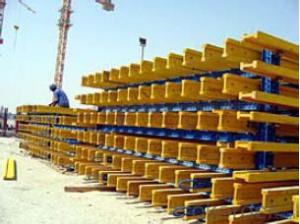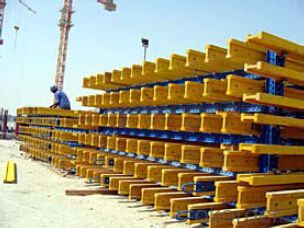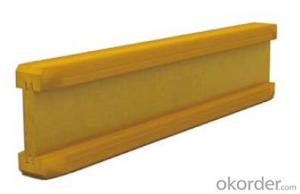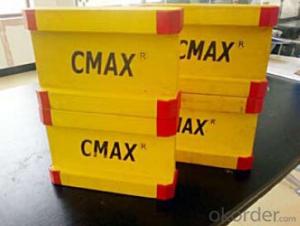Timber-Beam Plywood Formwork for Building Construction
- Loading Port:
- Tianjin
- Payment Terms:
- TT OR LC
- Min Order Qty:
- 50 m²
- Supply Capability:
- 1000 m²/month
OKorder Service Pledge
Quality Product, Order Online Tracking, Timely Delivery
OKorder Financial Service
Credit Rating, Credit Services, Credit Purchasing
You Might Also Like
Plywood --- make perfect concrete surface
WISA-Form Birch is a coated special plywood using in the formwork systems where high
requirements are set on the concrete surface and the times of reuses.
With CNBM timber beam & WISA plywood, the formwork is low weight but high load capacity, it is
widely used in construction.
Characteristics:
◆ Component with high standardization.
◆ Assembling in site, flexible application.
◆ Light weight, easy transportation and storage.

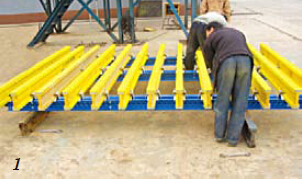
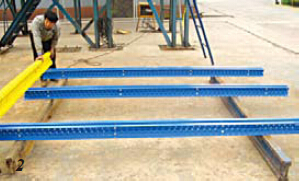
- Q: How does steel formwork contribute to the overall fire resistance of the structure?
- The fire resistance of a structure is primarily determined by the construction materials, including the type of steel used, the insulation and coating materials applied, and the overall design. Steel formwork, however, indirectly contributes to fire resistance by facilitating the construction of fire-resistant elements. It is commonly used in concrete construction to create walls, floors, and other structural elements. By providing a stable framework for pouring concrete, it enables the creation of fire-resistant concrete walls and floors that can withstand high temperatures and prevent the spread of fire. Steel formwork can also be used to create fire-rated concrete enclosures for important areas like stairwells and shafts. These enclosures help contain the fire and provide safe escape routes for occupants during emergencies. Additionally, steel formwork can incorporate fire-resistant materials such as insulation boards or coatings, which add another layer of fire protection to the resulting structure. Overall, although steel formwork itself does not directly contribute to fire resistance, it plays a crucial role in enabling the construction of fire-resistant elements and incorporating fire protection materials. This indirectly enhances the overall fire resistance and safety of the structure.
- Q: How does steel formwork perform in different weather conditions?
- Steel formwork performs well in different weather conditions. It is highly resistant to extreme temperatures, moisture, and UV radiation. This makes it suitable for use in both hot and cold climates. Steel formwork maintains its structural integrity and durability, ensuring consistent performance even in harsh weather conditions. Additionally, its non-absorbent nature prevents water damage or warping, making it a reliable choice for construction projects in various weather conditions.
- Q: How are steel formwork systems assembled and disassembled?
- A simple and efficient process is used to assemble and disassemble steel formwork systems. The process begins by erecting the steel panels, which interlock with each other using connecting devices like pins, wedges, or clips. These panels come in various sizes and shapes to meet different construction needs. To assemble the steel formwork system, the panels are aligned and connected based on the desired shape and dimensions of the structure. Pins or wedges are commonly used to secure the panels and prevent movement during concrete pouring. Once the panels are connected, support structures such as walers, props, and braces are installed. Walers are horizontal beams that connect the vertical panels, while props provide additional stability as adjustable vertical supports. Braces help resist lateral forces. During concrete pouring, the steel formwork system holds the wet concrete in place, giving shape and finish to the structure. After the concrete has cured and gained strength, the dismantling process begins. To disassemble the steel formwork system, the props and braces are removed first, followed by the walers. Once the support structures are taken down, the panels can be easily detached by removing the connecting devices. This can be done by pulling out pins or wedges or releasing clips. The disassembly process follows a systematic approach, starting from the top and moving downwards to ensure safety and prevent accidental collapse. It is important to follow safety guidelines and use appropriate tools to avoid damage to the formwork system or injury to workers. In conclusion, steel formwork systems are assembled by connecting panels and installing support structures, while the disassembly process involves removing support structures and disconnecting panels. This systematic approach ensures a safe and efficient construction process, allowing for the reuse of the formwork system in future projects.
- Q: What are the common durability issues with steel formwork systems?
- Steel formwork systems can encounter various durability issues. One major concern is corrosion, which arises when the steel comes into contact with moisture or harsh chemicals. If not addressed correctly, corrosion can weaken the formwork system's structural integrity and lead to premature failure. Another issue is wear and tear. Over time, repeated use of steel formwork systems can result in surface damage and deformation. This can create challenges in achieving precise and accurate concrete finishes, as well as pose safety risks for workers. Furthermore, mishandling and improper storage of steel formwork systems can cause bending or warping of the components. This can impact the overall stability and efficiency of the system, reducing its durability and reliability. Lastly, neglecting maintenance and failing to apply protective coatings can contribute to durability problems. Regular inspections, cleaning, and the application of protective coatings can prevent corrosion and prolong the lifespan of the steel formwork system. In conclusion, common durability issues with steel formwork systems encompass corrosion, wear and tear, mishandling and improper storage, and inadequate maintenance. Promptly addressing these concerns and implementing appropriate maintenance practices are crucial to ensure the longevity and effectiveness of the formwork system.
- Q: Can steel formwork be recycled?
- Indeed, the recycling of steel formwork is entirely possible. Steel, being a material with remarkable recyclability, can be effectively reused for different purposes subsequent to its utilization as formwork. Once the formwork has served its purpose, it can be gathered and dispatched to a recycling facility where it will undergo processing, ultimately transforming into fresh steel products. By recycling steel formwork, not only are natural resources preserved, but energy consumption is also reduced, and the volume of waste sent to landfills is minimized. This environmentally sustainable practice is gaining traction among construction companies and contractors as they strive to foster a circular economy.
- Q: What are the common challenges faced when using steel formwork?
- When using steel formwork in construction projects, there are several common challenges that need to be addressed. One significant challenge is the cost. Steel formwork is generally more expensive compared to alternative materials like wood or plastic. This can make it less accessible for smaller projects or those with tight budgets. Another hurdle is the weight of steel formwork. Due to its heavy nature, handling and transporting it on the construction site can be difficult. Specialized equipment and manpower are required to move and assemble the formwork, which adds to the overall project costs. Skilled labor is also needed for the installation and dismantling of steel formwork. The assembly process can be complex, and if not done correctly, it can lead to inaccuracies in the concrete structure. Experienced workers familiar with steel formwork systems are necessary to ensure proper alignment and security. Furthermore, regular maintenance and cleaning are necessary to ensure the longevity of steel formwork. Steel is prone to rust and corrosion, particularly when exposed to moisture or chemicals. This means that the formwork must be regularly inspected, repaired, and protected to prevent degradation or structural issues. Lastly, steel formwork is not as versatile as other types of formwork. It is typically used for repetitive and standardized projects that require the same formwork configuration repeatedly. This limitation can pose a challenge for projects that require unique or intricate designs. Despite these challenges, steel formwork offers several advantages, such as durability, strength, and reusability. It provides a stable and sturdy structure for pouring concrete, which leads to faster construction times and improved quality. However, it is crucial to carefully consider the specific requirements and constraints of a construction project before opting for steel formwork.
- Q: What are the different types of steel formwork available?
- There are several types of steel formwork available in the construction industry, each with its own unique features and advantages. Some of the most common types include: 1. Modular steel formwork: This type of formwork consists of prefabricated steel panels that can be assembled and disassembled easily. It is customizable and can be used for various shapes and sizes of concrete structures. 2. Tunnel formwork: As the name suggests, tunnel formwork is used for constructing tunnels and underground structures. It is made of steel plates and is designed to withstand high pressure and provide a smooth finish to the concrete. 3. Climbing formwork: This type of formwork is used for tall structures like skyscrapers. It is designed to be lifted and moved vertically as the construction progresses. Climbing formwork provides safety and efficiency while constructing multi-story buildings. 4. Steel soldier formwork: This is a versatile and cost-effective type of formwork that is commonly used for walls and columns. It is made of steel beams and soldiers and can be easily adjusted to different heights and widths. 5. Steel frame formwork: This type of formwork is made of steel frames with plywood or metal panels attached to it. It is lightweight, easy to handle, and provides a smooth finish to the concrete. 6. Steel table formwork: This is a type of formwork that is used for large horizontal slabs. It consists of steel tables that are supported by props or scaffolding. Steel table formwork is quick to assemble and dismantle, making it ideal for projects with tight timelines. These are just a few examples of the different types of steel formwork available. The choice of formwork depends on the specific requirements of the construction project, such as the type of structure, load-bearing capacity, and desired finish.
- Q: Is steel formwork suitable for projects with high wind loads?
- Yes, steel formwork is suitable for projects with high wind loads. Steel formwork is known for its strength, durability, and stability, making it an ideal choice for construction projects that are subject to high wind loads. Steel formwork provides excellent resistance against wind forces and can withstand strong winds without deformation or damage. Additionally, steel formwork offers a high level of dimensional accuracy, ensuring that the structure can withstand the forces exerted by the wind without compromising its stability. Therefore, steel formwork is a reliable and suitable option for projects with high wind loads.
- Q: How does steel formwork contribute to the overall cost-effectiveness of the construction process?
- Steel formwork contributes to the overall cost-effectiveness of the construction process in several ways. Firstly, steel formwork is reusable, allowing it to be used on multiple construction projects. This eliminates the need for frequent purchases or rentals of formwork, reducing costs in the long run. Secondly, steel formwork is durable and can withstand high pressures and loads, resulting in less damage or need for repairs during the construction process. This reduces downtime and saves on additional expenses. Lastly, steel formwork is highly efficient and can be assembled and disassembled quickly, saving labor costs and speeding up the construction timeline. Overall, the cost-effectiveness of steel formwork lies in its reusability, durability, and efficiency, making it a cost-saving choice for construction projects.
- Q: Are there any specific considerations for using steel formwork in areas with limited power supply?
- Yes, there are several specific considerations for using steel formwork in areas with limited power supply. Firstly, steel formwork typically requires power tools for assembly and disassembly. In areas with limited power supply, it may be challenging to operate these tools efficiently. Alternative methods such as manual tools or hand-held equipment may need to be used, which can significantly increase the time and labor required for formwork installation and removal. Secondly, steel formwork often requires welding or cutting, which typically relies on electricity. In areas with limited power supply, finding suitable alternatives for these processes becomes crucial. For example, gas-powered welding machines or oxy-fuel cutting equipment may need to be considered. However, these alternatives come with their own set of challenges, such as obtaining and storing fuel safely. Additionally, areas with limited power supply may also face issues related to lighting. Adequate lighting is essential during formwork installation and concrete pouring to ensure accuracy and safety. Using alternative lighting sources such as battery-powered or solar-powered lights may be necessary. Furthermore, steel formwork often requires proper cleaning and maintenance to ensure its longevity and reusability. Cleaning equipment, such as pressure washers or power scrubbers, may not be readily available in areas with limited power supply. In such cases, manual cleaning methods or low-power alternatives may need to be employed. Lastly, power supply limitations may also affect the overall productivity and efficiency of the construction project. With limited power, it may be necessary to carefully plan and schedule the use of power-intensive equipment, such as concrete mixers or pumps, to minimize disruptions and maximize the available power resources. In conclusion, using steel formwork in areas with limited power supply requires careful consideration and planning. Alternative methods, tools, and equipment may need to be employed to overcome the challenges posed by the lack of power availability. It is essential to assess the specific requirements of the project and consult with experts to ensure the successful implementation of steel formwork in such areas.
Send your message to us
Timber-Beam Plywood Formwork for Building Construction
- Loading Port:
- Tianjin
- Payment Terms:
- TT OR LC
- Min Order Qty:
- 50 m²
- Supply Capability:
- 1000 m²/month
OKorder Service Pledge
Quality Product, Order Online Tracking, Timely Delivery
OKorder Financial Service
Credit Rating, Credit Services, Credit Purchasing
Similar products
Hot products
Hot Searches
Related keywords

